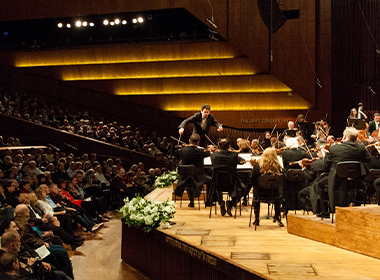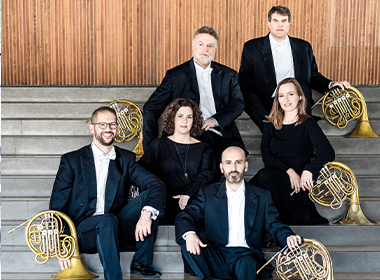”The most important thing to me is the meaning behind the music, the story behind it.” – Manfred Honeck
The IPO is delighted to host renowned Austrian conductor Manfred Honeck, Music Director of the Pittsburgh Symphony Orchestra, in a series of concerts with young Swiss baritone Manuel Walser, student of Thomas Quasthoff.
In early 1794, the day after the premiere of Haydn‘s Symphony no. 100, the London Morning Chronicle published a review of the concert. The paper described the work: “It is the advancing to battle, and the march of men, the sounding of the charge, the thundering of the onset, the clash of arms, the groans of the wounded, and what may well be called the hellish roar of war increased to a climax of horrid sublimity.” This response sounds naïve today, but it was the result of the triangle, cymbals, bass drum, and trumpet, which Haydn added to the usual timpani. The ”noise” apparently fascinated Haydn‘s English listeners at the time, and this symphony became known as the ”Military.” The Londoners were the first to hear the work, and through all the “noise,” the piece managed to speak to the hearts of its listeners—and it continues to do so today.
The Cantata BWV 82, “Ich habe genug” (”I have enough”), more literally means ”I have lived enough,” and it was one of Bach‘s favorites. He wrote several versions of the work for different voices, and in the last iteration, written shortly before his death, he added a role for oboe da caccia—an arch-shaped wooden wind instrument whose sound is lower than that of the oboe—to the work. Anna Magdalena, Bach‘s second wife, copied the music to her private notebook. The work speaks of a longing for death. It may seem strange, but in Bach’s time death was present in every house, and it was a wish that religious people expressed in lullabies. One Bach scholar theorized that the work was written around the time of the death of one of Bach‘s daughters, when she was only three years old. What is in fact known about the work, however, is that Bach composed the beautiful piece for an outstanding young bass, who sang it for the first time at the church of St. Thomas in Leipzig to mark the Feast of the Purification of Mary (Candlemas) on February 2, 1727.
The moniker ”Jupiter” was given to Mozart’s Symphony No. 41 by an English publisher shortly before its debut in England. Mozart, who finished the composition in August 1788, three years before his death, never heard the work performed. Symphony No. 41 is considered a mature symphonic work; its four-movement structure has the feel of a polyphonic improvisation in the spirit of Bach, and makes use of the well-known Sonata-Allegro form. Mozart split the roles of the cellos and contrabasses in order to achieve a richer string ensemble sound—rather than the typical four-voice sound with the cellos and basses playing the same part, the contrabasses now have their own independent part, adding a fifth voice to the texture.
The two children of the poet Friedrich Rückert died in a single night from scarlet fever. He coped with the loss by writing more than 430 poems about their deaths: rage and anger, followed by acceptance that his children were now in a better world. Using poetry from this collection, Mahler composed five songs between 1901-04, which make up the unconventional song cycle Kindertotenlieder (”Songs on the Death of Children”). He wrote these songs in different periods of his life: during his courtship of Alma, after their marriage, and after the birth of their daughters. He himself became a bereaved father about two years after he finished composing the work. The orchestration creates unity between the songs, building to the last song where we finally hear the full orchestral complement. It is truly meant to be a cycle, as Mahler noted in the score: “These five songs form a complete and indivisible whole, and for this reason their continuity must be preserved by preventing interruptions, such as for example applause at the end of each song.” Out of these songs came the famous Adagietto from Mahler’s Fifth Symphony and Der Abschied (“The Farewell), the concluding song from Das Lied von der Erde (”The Song of the Earth”).
When the conductor Manfred Honeck was a member of the Vienna Philharmonic, he played Richard Strauss’s Elektra under the baton of Claudio Abbado. Thrilled by the intensity of the orchestral presence, the symphonic dimensions of the dramatic work challenged him. This is the most symphonic piece among Strauss‘s operas, although the orchestra has a powerful presence in all of his operas. Honeck reflected: “I wondered why no one created a symphonic suite from this music—is it because it’s too complex? “Is it the daunting number of musicians—110—that Strauss demands for the opera? Puzzled for years, I went to the Czech composer Tomáš Ille and suggested that he write a symphonic poem that tell the cruel and complex story of Elektra.” Elektra is the daughter of Agamemnon and Clytemnestra; Clytemnestra and her lover Aegisthus kill Agamemnon and treat Elektra in a degrading manner. She does not accept their authority, but it is only when her brother, Orestes, arrives to avenge the death of their father, that anger leads to murder. Orestes kills Clytemnestra and Aegisthus, and Elektra subsequently goes mad and breaks into dance until she dies. The orchestral music in the opera is music of extremes, breaking from dramatic post-romanticism onto the precipice of atonality. Layers of complex sound and polyphony are hallmarks of the work. The Orchestra performs Honeck’s own symphonic adaptation of the opera, created in collaboration with composer Tomáš Ille.
Program no. 1
Manfred Honeck, conductor
Manuel Walser, baritone
Haydn: Symphony no. 100 ("Military")
Mahler: Kindertotenlieder
Strauss: Suite from Elektra








 Back to top
Back to top





